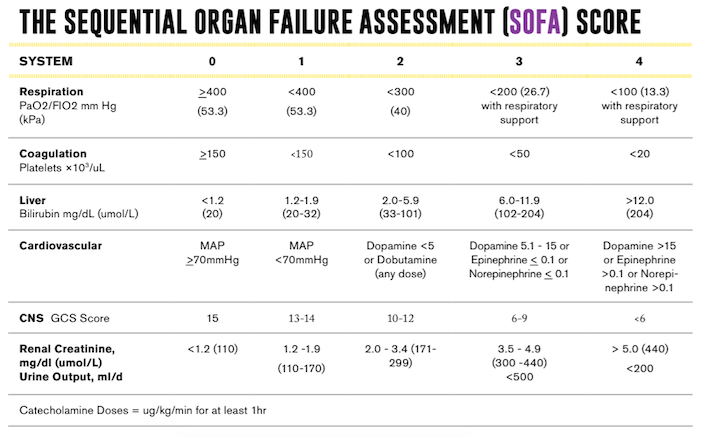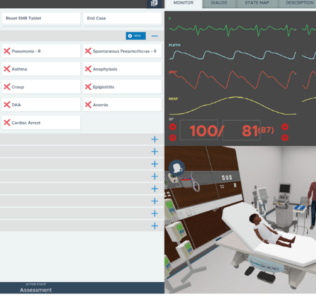Celebrating World Sepsis Day: Understanding Lab and Vital Sign Indicators for Simulated Sepsis Scenarios
As today is World Sepsis Day 2018, we are taking a look at ways to incorporate Sepsis into your simulation learning curriculum. According to the Journal of the American Medical Association (2016), sepsis is defined as the life-threatening organ dysfunction caused by a dysregulated host response to infection. Sepsis is a potentially life threatening complication which must be treated promptly. This article will list some of the potential indicators of sepsis that can easily be included in a simulation scenario, helping your learners better understand this potentially lethal infection.
Over the years, various protocols for the identification of patients with sepsis have been developed. Many hospitals use the Systemic Inflammatory Response Syndrome (SIRS) to identify patients at risk of sepsis. More recently, new research has led to the development of the Sequential Organ Failure Assessment (SOFA). Whichever system is used in your facility or local area, incorporating appropriate labs and vital signs into sepsis scenarios is a key to enhancing student learning.
Below is a helpful chart for the criteria, value ranges and key understandings for Sepsis to consider using in your simulation scenarios.
Sponsored Content:
About World Sepsis Day 2018
TODAY is World Sepsis Day! It is the biggest yet, with countless events in all parts of the world.
There are events for medical professionals, sport activities, photo exhibitions, pink picnics, gala events, dinners, public events such as open houses in hospitals and healthcare facilities, and of course online events such as the ‘2nd World Sepsis Congress’, and campaigns on social networks. What will you do to raise awareness for sepsis?
World Sepsis Day is held on September 13th every year and is an opportunity for people worldwide to unite in the fight against sepsis. Sepsis accounts for at least 8 million deaths worldwide annually. Yet, depending on country and education, sepsis is known only to 7 – 50 % of the people. Likewise, it is poorly known that sepsis can be prevented by vaccination and clean care and that early recognition and treatment reduces sepsis mortality by 50 %. This lack of knowledge makes sepsis the number one preventable cause of death worldwide. Visit the WSD website for tools to use today to help share the message of Sepsis awareness, like the video here:
Sponsored Content:
Additional Sepsis Resources from Patient Safety Movement Foundation
The Patient Safety Movement is not just about information, it is about action! By addressing new challenges and forming Actionable Patient Safety Solutions (APSS) the PSMF believes we can reduce the number of preventable deaths in hospitals to ZERO by 2020.
On the PSFM website, you will find links to 16 challenges and 30 solutions to overcome some of the leading patient safety challenges facing hospitals today. Please take the time to download and share these APSS with your colleagues. If you haven’t made a commitment to implement these solutions, please consider making a commitment today.
APSS #9 is a resource for the Early Detection and Treatment Of Sepsis: Sepsis occurs when the body reacts to an infection and releases chemicals that cause inflammation as well as organ failure. Early detection of sepsis, with the timely administration of appropriate fluids and antibiotics, appear to be the single most important factors in reducing morbidity and mortality from sepsis. It has become increasingly apparent that there is a long delay in both the recognition of sepsis and the initiation of appropriate therapy in many patients. This translates into an increased incidence of progressive organ failure and a higher mortality. Healthcare providers, therefore, need to have a high index of suspicion for the presence of sepsis and must begin appropriate interventions quickly.
Lab and Vital Sign Indicators for Simulated Sepsis Scenarios
| Criteria | Values | Note |
| Temperature | > 101’F or <96.8’F | Fever expected with infection. Hypothermia more serious – an indicator of an impaired immune system. |
| Respiratory Rate
PaO2/FiO2 |
>22 breaths/min
< 400 mmHg (kPa) |
Causes of tachypnea in sepsis are multifactorial but the lung is the most common site of infection. Tachypnea is a compensatory mechanism for metabolic acidosis.
PaO2/FiO2 ratio is the ratio of arterial oxygen partial pressure to fractional inspired oxygen. AKA the Carrico index and the PF ratio. It is a widely used clinical indicator of hypoxaemia (low blood oxygen). |
| Heart Rate | >95 bpm | Tachycardia is part of the systemic immune response to infection. Heart rate increases approximately 10 beats per minute for every one degree Centigrade rise in temperature. |
| WBCs | >12,000/mm3 OR <4000/mm3 OR > 10% immature neutrophils (bands) |
Complex leukocyte changes occur during sepsis which can lead to low white cell counts and exhaustion of neutrophils. Neutrophils (polymorphonuclear leukocytes PMNs) are one of the first lines of defence. A phenomenon called “shift to the left” occurs the percentage of neutrophils increases. |
| Platelets | <150 ×103/mm3 | Fibrinolytic and fibrinogen substances are depleted, and formation of clots and bleeding associated with disseminated intravascular coagulation (DIC) occur at the same time. In the end, DIC results with increased platelet destruction. |
| Blood glucose | >140 mg/dL but <200 mg/dL in non-diabetic patient. | Blood sugars maybe become elevated during inflammatory responses and stress. |
| Bilirubin | > 2 and < 10 | Caused either directly from bacterial products or as a consequence of the host’s response to infection.
Sepsis also induces liver damage through hemodynamic alterations or through direct or indirect assault on the hepatocytes or through both. |
| Creatinine | Elevated 0.5 above baseline within 72 hour period. | Over 50% of patients with sepsis develop acute kidney injury. Creatinine elevation indicates kidney damage. Note initially, sepsis reduces production of creatinine, which blunts the increase in serum creatinine after sepsis, potentially limiting the early detection of acute kidney injury. This may partially explain why small absolute increases in serum creatinine levels are associated with poor clinical outcomes. |
| Lactate level | >2 | Lactate elevation in sepsis seems to be due to endogenous epinephrine stimulating beta-2 receptors. Particularly in skeletal muscle cells, this stimulation up-regulates glycolysis, generating more pyruvate than can be used by the cell’s mitochondria via the TCA cycle. Excess pyruvate is converted into lactate. This process is entirely aerobic, occurring despite adequate oxygen delivery. Increased lactate levels leads to acidosis. |
| Mean Arterial Pressure/SBP | <65 or SBP<90 | Sepsis occurs when toxins produced by certain bacteria cause cells in the body to release substances that trigger inflammation (cytokines). Although cytokines help the immune system fight infection, they can have harmful effects:
Dopamine may be required to maintain BP. |
| Central Nervous System (CNS) Glasgow Coma Scale (GCS) | Variable <13 to <6 | GCS was designed to give a quantitative measure of brain function. The scale is made of three components – eye (4 points), motor (5 points) and verbal response (6 points). The maximum score is 15. The lower the number the worse the score e.g. 13 minor injury, 3 deep unconsciousness or death. |
| See Illustration for scoring SOFA indicators. | ||
Fidelity in simulation is a key factor for student learning. The addition of relevant assessment data such as labs and vital signs can add significantly to the fidelity of any given scenario. A future article will discuss sepsis interventions in more detail.
Today’s article was guest authored by Kim Baily PhD, MSN, RN, CNE, previous Simulation Coordinator for Los Angeles Harbor College and Director of Nursing for El Camino College. Over the past 16 years Kim has developed and implemented several college simulation programs and previously chaired the Southern California Simulation Collaborative.
Have a story to share with the global healthcare simulation community? Submit your simulation news and resources here!
Learn more about Sepsis from the Journal of Thoracic Disease
Dr. Kim Baily, MSN, PhD, RN, CNE has had a passion for healthcare simulation since she pulled her first sim man out of the closet and into the light in 2002. She has been a full-time educator and director of nursing and was responsible for building and implementing two nursing simulation programs at El Camino College and Pasadena City College in Southern California. Dr. Baily is a member of both INACSL and SSH. She serves as a consultant for emerging clinical simulation programs and has previously chaired Southern California Simulation Collaborative, which supports healthcare professionals working in healthcare simulation in both hospitals and academic institutions throughout Southern California. Dr. Baily has taught a variety of nursing and medical simulation-related courses in a variety of forums, such as on-site simulation in healthcare debriefing workshops and online courses. Since retiring from full time teaching, she has written over 100 healthcare simulation educational articles for HealthySimulation.com while traveling around the country via her RV out of California.
Sponsored Content:






















